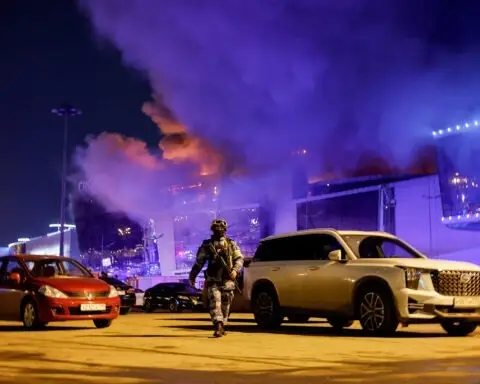WASHINGTON — Nearly three years after U.S.-backed forces in Syria seized the last remaining territory held by Islamic State’s self-declared caliphate, members of the global coalition charged with eradicating the terror group warn their task is not getting any easier.
Despite IS’s loss of several key leaders and intelligence that suggests a dwindling number of fighters in the core areas of Iraq and Syria, coalition members say the reputation and ideology of the group — also known as ISIS or by the Arabic acronym of Daesh — continues to hold its affiliates together while fostering its growth.
Officials attending Wednesday’s ministerial in Marrakesh, Morocco, say nowhere is the threat more worrisome than in Africa, where a joint coalition communiqué described IS as an “evolving threat.”
“Our shared assessment of the dangerous rise of terrorist threat in Africa has led to the emergence of a tailored approach of the coalition’s support to the African continent,” Moroccan Minister of Foreign Affairs Nasser Bourita said following the meeting.
IS in Africa
The United States, which co-hosted the ministerial with Morocco, emphasized the need to strengthen African members of the Defeat ISIS coalition with what U.S. officials have called a civilian-focused approach.
“ISIS and other terrorist groups frequently style themselves as alternatives to the state, and so it is critical that we work with our partners to increase state capacity to provide services and security to their people,” said U.S. Undersecretary of State Victoria Nuland.
“The United States is committed to working with our partners in West Africa to confront the challenges that have allowed this group to flourish. Among them, the lack of state legitimacy, persistent rights violations, and food insecurity,” she added.
Other U.S. officials have told VOA the threat from IS in Africa has become increasingly dire, with affiliates in West African countries and the Sahel finding ways to increase their numbers, in many cases simply by preying on local grievances.
Intelligence estimates from countries working with the United Nations put the number of IS affiliated fighters in Nigeria, Niger, Cameroon, Chad, Mali and Mozambique at more than 7,000, with some U.S. and Western counterterrorism officials warning that the numbers are growing still.
For all the focus on pushing back against IS in Africa, however, the global coalition, and U.S. officials in particular, stressed the need not to lose sight of the threat still posed by IS in Iraq and Syria, and in Afghanistan.
“ISIS in Iraq is a clandestine threat and a very serious one to carry out massive attacks,” Doug Hoyt, acting U.S. deputy envoy to the coalition, told VOA prior to the ministerial.
Iraq
“We’re still seeing ISIS elements, really, in the seam between Iraqi Kurdistan and greater Iraq, as well as some of the border territories in Nineveh,” Hoyt said. “And I think that’s going to be a problem for Iraq until we solve Syria.”
Intelligence shared by various countries with U.N. counterterrorism officials indicate the terror group has between 6,000 and 8,000 fighters spread across Iraq and Syria, with a U.N. report issued this past February describing IS as “an entrenched rural insurgency.”
Earlier U.S. intelligence estimates warned IS numbers in Iraq and Syria could be even greater, in the 8,000-16,000 range.
And information shared by the U.S. Defense Intelligence Agency for a recent Defense Department inspector general report said the terror group appears to be operating mainly in Syria’s central desert, while continuing what the agency called a strategic retreat.
Other measures, though, indicate that the threat from IS in Syria may again be growing.
Syria
U.S. counterterrorism officials have raised concerns about IS’s attack on the al-Sina’a prison in Hasakah, Syria, this past January, a bold and complex plot that sought to free as many as 4,000 IS prisoners.
More recently, the Rojava Information Center, a pro-Kurdish research group, said IS sleeper cells carried out 54 attacks across northeastern Syria in April, a 184% increase over the previous month.
There are also ongoing concerns about the approximately 10,000 IS fighters, including about 2,000 foreign fighters, still being held in prisons run by the U.S-backed Syrian Democratic Forces.
For years, the U.S. has urged other nations to repatriate their IS fighters from Syria. And officials told VOA that effort continues.
“We’re trying to set an example in the U.S. by repatriating individuals that are U.S. citizens, and we’re also working to help countries that have questions or have issues to repatriate,” said Dexter Ingram, acting director of the State Department’s Office of the Special Envoy for the Global Coalition to Defeat ISIS.
“A lot of folks are kind of looking to change their laws so that when these individuals are prosecuted — if they’re prosecuted — that they have longer sentences,” Ingram added.
In the meantime, the State Department on Wednesday pledged another $350 million to communities in northeastern Syria and another $350 million to Iraq to help stabilize communities that had been ravaged by IS.
For some officials in Syria, that money cannot come soon enough.
“This is very important to create jobs for the young people in order to avoid them to be recruited by ISIS,” Sinam Mohamad, U.S. representative for the SDF’s political wing, the Syrian Democratic Council (SDC), told VOA.
Afghanistan
Coalition members Wednesday also acknowledged growing fears about a possible resurgence of IS in Afghanistan, with the communiqué calling the affiliate, also known as IS-Khorasan Province, “a growing threat to the South and Central Asian region.”
“Everybody’s watching that right now,” the State Department’s Ingram told VOA before the ministerial meeting.
“The reality is that we are already starting to engage with our Central Asian partners, even if they’re at the observer status, at the highest level,” he said.
U.S. defense and counterterrorism officials began warning more than a year ago that IS in Afghanistan had begun laying a foundation for a revival, while observers in the region told VOA the group was looking to gain footholds in neighboring countries, including Kazakhstan, Kyrgyzstan and parts of Tajikistan.
Intelligence estimates shared by the U.N. earlier this year said the affiliate had more than doubled in size, to more than 4,000 fighters, since U.S. forces left Afghanistan last August.
On Tuesday, DIA Director Lieutenant General Scott Berrier told lawmakers in Washington that IS-Khorasan could reconstitute its ability to launch attacks on targets outside of Afghanistan in “probably a year, (or) slightly longer.”
“The fact that they have had some successful and catastrophic attacks … does not portend well for the future,” Berrier added.
Information from The Associated Press was used in this report






